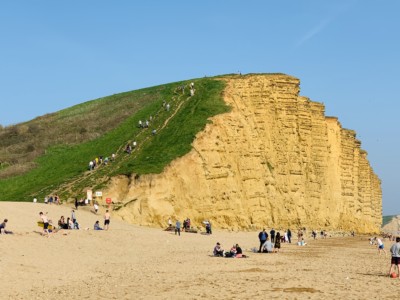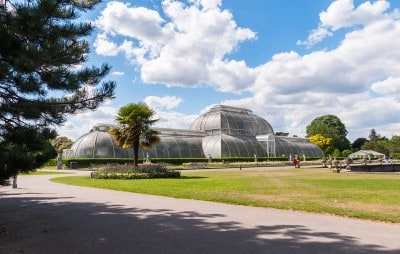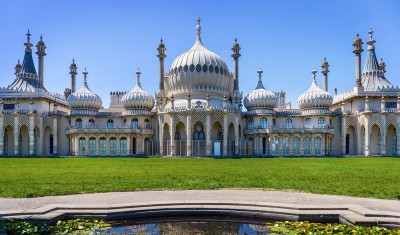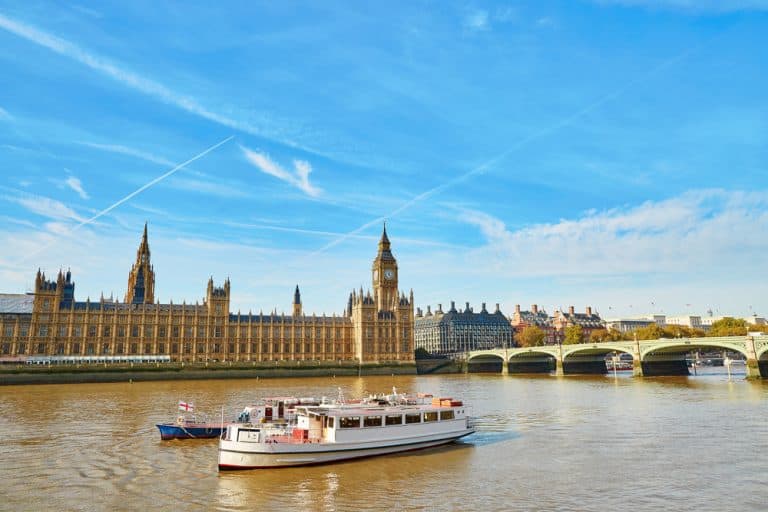The top things to do on your weekend in Bath
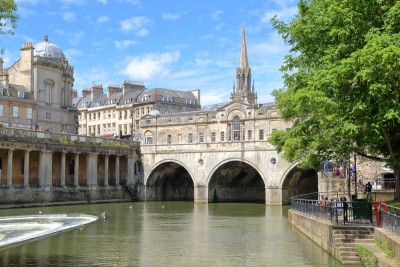
By Emma Marshall
When people ask where they should go for a short break in England, then one of the top places that comes up is a weekend in Bath.
A UNESCO World Heritage site, it’s a beautiful Georgian city in the south west of the country and a delightful place to visit. There’s plenty to see and do and the fact that the city is founded on natural hot springs makes it one of the top places to visit for a spa break.
Read on to discover the top things to do and for information to help you plan your weekend in Bath.
This post contains affiliate links
Where is Bath?
Bath is in the county of Somerset, in the south west of England. It is less than 15 miles from the city of Bristol (making it an easy two city break) and around 115 miles from London.
It is also well located for other places that you may be interested in exploring. Salisbury is around 40 miles around in one direction and Cardiff in Wales around 60 miles in the other direction. Prehistotic Stonehenge is around 30 miles away.
How to get to Bath
It’s really easy to get to Bath. You can catch direct trains from London Paddington to Bath Spa station. These take around 1 hour 20 minutes. The train station is then just a short walk from the main city centre.
You can also travel to cities elsewhere in the south west (Exeter takes between an hour and a half, and two hours on the train) or in Wales (Cardiff takes between an hour and an hour and a half). Birmingham is around two hours to two and a half hours via Bristol.
More locally, there’s Bristol. This is just over 10 minutes by train. There are around three trains an hour.
If you’re driving to Bath, it will take around two to two and half hours from London via the M4.
The Visit Bath website recommends using the Park and Ride Services when you arrive in the city to avoid the busy city centre roads. The locations of these can be found on the downloadable map on their website.
If you’re visiting the UK from overseas, Bristol airport is only 20 miles away and there is a bus service that connects the airport to Bath.
How to get around Bath
Bath is a relatively small city, as cities go. This makes it the perfect place to visit for a short break; everything you’re likely to want to see and do are fairly close together.
This also means it’s a really easy place to walk around. You therefore don’t need to worry too much about public transport networks and timetables.
However, if you do want to take the weight off your feet a bit more, then consider booking this hop-on-hop-off bus.
Or if you fancy booking onto a group walking tour, click here.
Where to stay in Bath
When considering where to stay in Bath, there are plenty of options to choose from.
Below I have selected some that I think would be a good choice for a weekend in Bath.
Suggestions for where to stay in Bath
The DoubleTree by Hilton hotel is in a perfect location for a weekend in Bath: it is situated right by the main old part of Bath and by the river, and is just a five minute walk from the train station.
It has a bar and restaurant as well as an outdoor “Secret Garden”.
The Abbey Hotel Bath: another ideally situated hotel, the Abbey Hotel Bath is a lovely hotel in the heart of things.
It’s housed in a beautiful building and has a stunning restaurant and bar and some wonderfully designed bedrooms. It comes highly recommended by a friend who visits Bath multiple times a year and always stays here!
The Gainsborough Bath Spa: Not far from the Roman Baths Museum is the Gainsborough Bath Spa. This is a luxurious, 5-star hotel, situated in Grade II listed buildings.
In a nod to the city’s history of thermal spa waters, it has its own spa with natural thermal waters, a sauna and steam room. It would be a great choice if you’re looking for romantic things to do in Bath.
The Roseate Villa: on the other side of the river from the old part of Bath, but still within a short walking distance of all the sights, is the boutique Roseate Villa. You stay in a converted Victorian building which boasts “a warm welcome with tea and cakes”.
The hotel overlooks Henrietta Park and has its own outdoor garden.
The Travelodge Bath Waterside: if you’re looking for a more budget stay, then you could consider the Travelodge. I stayed here for a night and although it is a basic hotel, it was clean, good value for money and had a small bar and restaurant.
Note that it is slightly further out than the hotels listed above, but if you don’t mind a short walk, it would be a good option.
To explore more options for best places to stay in Bath, click here.
The best time to visit Bath
The south west of England experiences relatively mild temperatures and even in the winter rarely goes into minus figures (although you might want to pack an umbrella as there are lots of rainy days in the UK!).
Visiting between May and early October will give you warmer and longer days, ideal for sightseeing. July is generally the warmest month of the year.
The winter months are also a good time to visit for a weekend in Bath. The streets are lit up and there are plenty of cosy tea rooms to dive into to escape the cold. At Christmas, there is traditionally a Christmas market to visit.
You might also want to time your trip to coincide with local events in the area.
In Spring 2021, the rescheduled 2020 Bath Festival will take place. This will include performances of the Beethoven String Quartets in March.
The Festival Finale Weekend is now scheduled to take place on the weekend of 29-30 May.
Nearby Bristol also holds an annual international balloon fiesta where over 100 hot air balloons take to the skies. It’s quite a spectacular sight.
In 2021, the festival will take place between 12th and 15th August.
What to do on your weekend in Bath

There’s no shortage of things to choose to see and do on a weekend in Bath. In fact, it may be harder to decide what not to do.
Your choice will very much depend on the type of weekend you are planning: a sightseeing weekend, a spa weekend, or a weekend exploring the local area more widely.
Below I set out the top things that I think you should consider for your weekend in Bath.
Learn about the history of the city in the Roman Baths Museum

In my opinion, a trip to the Roman Baths Museum is an absolute must. After all, it’s the place from which the city takes its name.
The museum can be found in the heart of the city, and deserves at least two or three hours of your time. A visit here gives you the chance to not only see the remains of the actual baths, but to learn about the history of the city, as well as life during the times of the Romans.
History of the Roman Baths
The museum is housed on the site of the old Roman baths, known at that time as Aquae Sulis (the Waters of Sulis). Here warm springs had formed from rainwater seeping into the local limestone which were then pushed up through cracks in the rocks.
Apparently, Iron Age settlers had long worshipped the springs, but with the Roman invasion, a new era emerged: the Romans channelled the waters and built a sanctuary.
When you visit the museum, it’s striking how similar the baths were to modern day spas. Not only were they used for bathing, they were also an important hub for socialising or holding meetings (although I’ve never been to a modern spa where board games are played or entertainers wander around!).
The baths were also a place where ailments could be cured (the water apparently contains over 40 minerals).
Some also came to worship the Goddess Sulis Minerva (you can see a bronze head from the original temple here) and to make sacrifices or wishes.
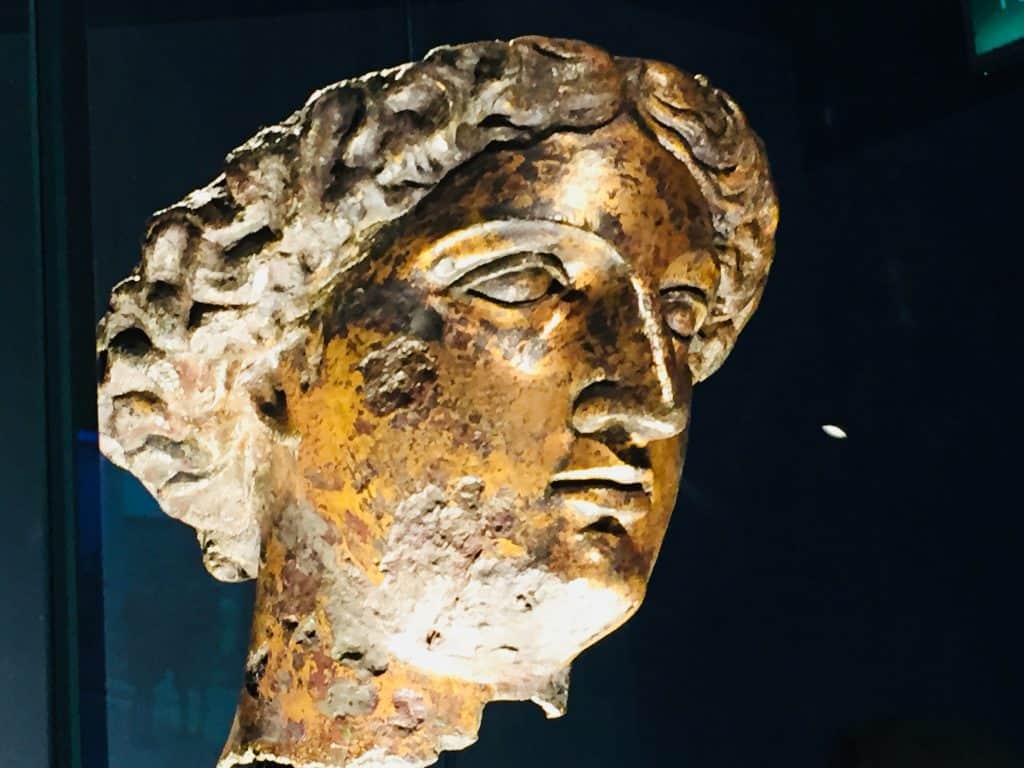
Excavations of the site uncovered jewellery and coins, which were left as gifts.
As with many modern spas, the Romans had saunas, steam rooms, and plunge pools, as well as dressing rooms for visitors.
The remnants displayed in the museum reveal how sophisticated the Romans were. To provide these services, they had to line pools with lead, put in piping, raise floors and install underfloor heating.
The lengths they went to brought home to me just how significant this site was. This is further reinforced by the displays in the museum which show just how far people were travelling – from all over Europe – to visit Aquae Sulis.
The Great Bath

The largest of the baths, the Great Bath, is a perfect place to sit and ponder what it must have been like during Roman times.
There are alcoves set back in the stone walls where you can recline and soak in the majesty of your surroundings. At first the water looks inviting, until you discover that the vibrant green colour is due to years of algae growing in the water.
Look up and above you are imposing statues of Roman Emperors flanking the walkway. Bath Abbey is in the background.

The King’s Bath
When you do move on, you will come across the hot water in the King’s Bath. Bubbles form on the surface of the water here and steam rises upwards (the temperature reaches 46 degrees).
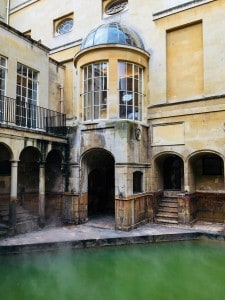
Unfortunately, it’s not possible to take a dip in these waters, although you can sample it before you leave the museum. I did, and I can say that it’s not exactly refreshing as it’s quite warm – but you really can’t leave without trying it.
Overall…the museum is a must on any visit to Bath. Apart from walking around the Baths where you can imagine yourself in a bygone age, there is a wealth of information on hand and superb artefacts to view. The learning to be had here is vast.
Click here to book a guided tour.
Have lunch in the Pump Room restaurant
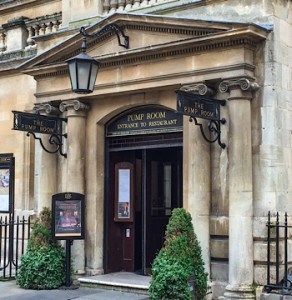
After your visit to the Roman Baths museum visit you can literally walk through to the Pump Room restaurant for lunch. I would thoroughly recommend this (you don’t need to have visited the museum to reserve a table in the restaurant though).
You dine in a lovely light and airy room. There’s a strong calming ambience to the room which oozes relaxation, and when I visited there was a piano player tinkling away in the background. It’s great for either a full meal or a quick snack.
You can also try the spa water here with its 43 minerals: something to do if you’ve already been through the museum and seen the waters first-hand.
The Pump Room has events that you can book onto. In the run up to the festive season, you can book candlelit evening meals, or special afternoon teas – with or without champagne.
Chill out in the Thermae Bath Spa

After a few hours learning about the history of the city’s thermal waters in the Roman Baths Museum, I felt like I thoroughly deserved a spa myself. If you feel the same, then you’re in luck as Bath boasts an amazing spa only a few minutes away.
The Thermae Bath Spa harks back to the city’s past as a spa town. There’s the main New Royal Bath and The Cross Bath, right across the street (according to the information provided by the spa, the latter is an “official sacred site”.)
I visited the New Royal Bath. Here you can alternate between the spa baths and the “wellness rooms”. The latter include steam rooms, an ice chamber, an infrared room and a relaxation room.
However, the icing on the cake is the rooftop heated bath where you can immerse yourself in wonderfully warm waters (around 33.5 degrees centigrade). You can do this whilst peering out over this UNESCO world heritage city.
Go on a winter night like I did and you can see the steam rising off the water and the wonderful Bath Abbey lit up behind in the night sky.
A visit here is not to be missed. And it’s a top thing to do if you’re looking for romantic things to do in Bath.
Top tip for visiting the Thermae Spa Bath
The Thermae Bath Spa has the large New Royal Bath and the smaller Cross Bath.
Both are popular and so I’d advise giving the Spa a call beforehand to find out when the quietest time to visit is. Although I had a fabulous time here, I would have preferred it to be a little less busy. The Cross Bath can be hired for exclusive use.
Booking in advance is also essential at the moment: click here for more information.
If visiting spas is your thing, also see my post on a spa visit in Zurich and a hammam experience in Marrakech.
Explore Bath’s Georgian architecture
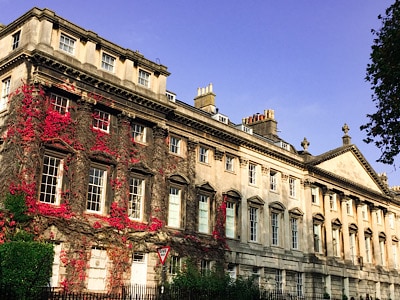
As you walk around Bath, you will see plenty of examples of Georgian architecture.
If this is something you’re into, you’ll love exploring the city and snapping gorgeous images of the streets and buildings. Below are some key places to include on this (or click here for walking tours).
The Bath Assembly Rooms
The Bath Assembly Rooms, located in Bennett Street, were a place for socialising: for people to come together, to dance in the Ball Room and to drink tea in the Tea Room.
According to the website “When they were completed in 1771 they were described as ‘the most noble and elegant of any in the kingdom’.
When not in current use, you’re able to visit the rooms. The city’s Fashion Museum is also located here.
The Royal Crescent

During your wanders, you must make sure you take the short stroll from the city centre to the Royal Crescent.
Overlooking the Royal Victoria Park, it is cited on the Visit Bath website as “without doubt one of the greatest examples of Georgian architecture in the UK”.
Its sweeping arc is stunning and photographers will be itching to capture its Georgian splendour.

No.1 The Royal Crescent
After taking in this wonderful sight, pop into No 1 the Royal Crescent. This is now a museum that is presented as it would have been during the Georgian era. I visited and found it was a great way to learn more about the Georgians.
Note the museum is currently closed until April 2021
The Circus
Similar to the Royal Crescent, the Circus is another magnificent Georgian structure. Here there are three arcs that form a circle. It was originally designed by John Wood, the Elder, but finished by his son in 1768.
It is near to the Royal Crescent and the Assembly Rooms, so stop by here en route. You can also visit it and learn more about its history on this walking tour of Bath.
Great Pulteney Street
A Georgian architecture walk should also include the 18th century Great Pulteney Street. Visit Bath says this is the widest street in the city and adjoined by the shortest street.
Learn about one of Bath’s most famous residents
It’s obvious when you visit Bath that it is very proud of its connection to the author, Jane Austen, who lived in the city for five years from the start of the 19th century.
Two of her famous books – Persuasion and Northanger Abbey – are also set in Bath.
The Jane Austen Centre
The Jane Austen Centre, located in a Georgian building in the city, provides a wealth of information about its famous inhabitant, complete with a waxwork model of the author.
You can even dress up in traditional costume or try writing with a quill if you want to get a feel for life at that time. Click here for tickets.
Upstairs is the Regency Tea Room if you want to stop after your visit and have tea and cake. You’ll be served by staff in costume for more of a traditional experience.
Parade Gardens
Another lasting legacy to the author can be found in the Parade Gardens. This a few minutes from the city centre, where what I can only describe as a botanical book has been placed.
This has a quote from Northanger Abbey, “Oh who can ever tire of Bath?” in full view (having visited, I can quite agree with this sentiment!).

Visit Parade Gardens and take a look at the Pulteney Bridge
Parade Gardens is worth a visit even if you’re not there to see the Jane Austen book with its Northanger Abbey quote.
Covering 2.5 acres, it’s a lovely spot to spend some time and was incredibly peaceful when I visited. The park runs alongside the River Avon, not far from its weir and the attractive 18th century Pulteney Bridge.

The bridge is apparently only one of four bridges in the world where you’ll find shops across the entirety of it span.
There is also a bandstand in the gardens where you can attend open-air concerts during the warmer months.
Note that between April and October, there is a small charge for entering the gardens (£2.00 for adults and £1.00 for concessions). Dogs are not permitted in the gardens.
Experience the magnificent Bath Abbey

This impressive 7th century building stands grandly outside the Roman Baths. It’s definitely worth a visit with its magnificent stained-glass windows and fan vaulted ceiling.
There are also apparently over 600 memorials lining the walls of the Abbey. There’s also a huge bell at the far end as you walk in.
In normal times, there are tower tours that you can book on. These provide a great vantage point from which you can look over the city.
Visit a traditional tea room and sample the Bath Bun
A visit to Bath would not be complete with sampling the Bath Bun.
One of the most famous tea rooms is Sally Lunn’s, where the Sally Lunn bun, (said to be the first Bath Bun), is a local delicacy. It’s also housed in one of Bath’s oldest buildings.
It’s a popular place to visit, so much so, that you may have to queue for a table.
However, there are other plenty of other tearooms nearby where you can also savour the bun’s delights (or a variety of this).
You can also have a formal afternoon tea in the Pump Room Restaurant and some of the local hotels. These include the Roseate Villa and the Bath Priory.

Visit a Bath museum
Bath has impressive selection of museums so if you plan to visit, why not consider checking out one of the following:
The Museum of Bath Architecture
If wandering around has whetted your appetite to learn more about the city’s architecture, then visit the Museum of Bath Architecture. You’ll get more information about the history of the city’s various different eras here.
The museum is located in The Countess of Huntingdon’s Chapel, not far from the Jane Austen Centre. It is open every afternoon until the end of November (in July and August it opens slightly earlier at 11am).
The Victoria Art Gallery
This museum contains a range of art and sculptures, including British oil paintings from the 17th century. In addition to an actual visit (note that the museum is currently closed until March 2021) the museum’s website has a large amount of online information and exhibitions that you can tap into.
These include a collection of pictures depicting Jane Austen’s life in Bath, information on caracurists from the Georgian period, and a collection of recruiting posters from the First World War.
The Fashion Museum Bath
Located in the Georgian Assembly Rooms, the Fashion Museum “holds a world-class collection of contemporary and historic dress”. There are apparently almost 100,000 items to view here.
The museum is currently closed (until March 2021), but there are interesting sections of their website to keep you going before then (see for example, the images of fashions from the 1970s and 1980s).
The Herschel Museum of Astronomy
In its own words, this museum is “dedicated to the many achievements of the Herschel’s, who were distinguished astronomers as well as talented musicians. It was from this house, using a telescope of his design that William discovered the planet Uranus in 1781”.
You can visit to learn more, explore parts of their house, and browse their collection which includes a variety of telescopes and globes, as well as William Herschel’s travel diary.
There’s also a music room and workshop to explore and you can take part in star gazing sessions in the garden.
The Jane Austen Centre
The Jane Austen Centre is a perfect place to visit if you’re a fan of the writer. Located centrally in a Georgian building, there’s a wealth of information here about its famous inhabitant, complete with a waxwork model of the author.
You can even dress up in traditional costume or try writing with a quill if you want to get a feel for life at that time.
No.1 The Royal Crescent
As outlined above, you could combine a visit here with a walk up to the Royal Crescent. The house is now a museum that is presented as it would have been looked during the Georgian era – a great way to learn more about the Georgians.
Note the museum is currently closed until April 2021.
Other things to do on a weekend in Bath
A weekend in Bath at Christmas
Bath is a beautiful city and Christmas in Bath is particularly special. The streets are lit up and you can snuggle up in cosy tea rooms to get out of the cold.
The city usually holds a Christmas market during the festive season. It has been postponed in 2020 due to the coronavirus pandemic, but in past years, it’s been a popular place to visit.
As a compromise, this year there will also be 12 chalets positioned at various points around the city. These will sell locally made products against a backdrop of illuminated city centre buildings.
There are also plenty of shops in Bath that will provide ample opportunities for Christmas shopping.
A Bath river cruise
If you’d like to experience the city from the river, there are some boat trips you can book onto.
These travel along the River Avon and give you the chance to see some of the main city sights from the water, including Bath Abbey, Pulteney Bridge and the weir.
Click here for more information.
A trip outside of Bath
If you’re staying in Bath for more than a weekend, you may want to combine your trip with a visit to other places.
Bristol is just over 10 minutes away on the train (around 30 minutes by car) and is worth a visit. It’s bigger than Bath, but has a historic centre and a lovely quayside area.
Stonehenge, another World Heritage Site, is around 30 miles away. A prehistoric ring of standing stones, it’s a popular place to visit and has an exhibition.
There is a café and gift shop. There is also a car park if you plan to drive here. However, if you’re not driving, you will need to reach Stonehenge via the train to Salisbury.
Organised tours to and from Bath
If both Bath and Stonehenge are places you’d be interested in, but you don’t want to stay overnight, you could consider this tour which takes you to both from London.
These tours also combine Bath, Stonehenge and Windsor (if a trip to the Windsor and Windsor Castle is something that interests you, see my recent post on a day trip here).
A 2-day itinerary for your weekend in Bath
The following provides an itinerary for your weekend in Bath.
There’s actually lots to do – within Bath and further afield – that would make this an ideal place for a longer trip.
However, if your time is limited and you cannot for stay for longer than a weekend in Bath, I would suggest trying to prioritise those places that I have flagged in the itinerary below.
[su_box title=”A 2-day itinerary for your weekend in Bath” style=”soft” box_color=”#1741bd”]
Day 1
Mid-morning: arrive and head to the Roman Baths Museum
Lunchtime: Have a light lunch in the Pump Rooms
Early afternoon: After leaving the Pump Rooms, pop into Bath Abbey; if possible take a tour up the tower
Mid-afternoon: Visit one of the museums in Bath: perhaps learn more about Jane Austen or stop off at the Fashion Museum in the Assembly Museums. Stop off for afternoon tea.
Late afternoon: walk off your afternoon tea with a stroll along the River Avon and Parade Gardens before heading back to your accommodation or evening drinks and dinner
Day 2
Morning: Take a morning walk around the city to see some of the Georgian architecture. Walk up to the Royal Crescent via the Circus and Great Pulteney Street. Then drop into Sally Lunn’s team room to try the famous Bath Bun.
Mid-late morning: Head to the Thermae Spa for some rest and relaxation and a chance to see the city from the rooftop heated pool
Early-late afternoon: grab a late lunch. Then visit some of the city’s shops to grab some souvenirs. In the summer you could take a quick cruise on the River Avon, or in December you could visit the Christmas market before heading back home.
[/su_box]Other ideas for short breaks
I hope this has demonstrated the top things to do on a weekend in Bath.
For more ideas for short trips in the UK, you may be interested in other places I have written about:
- A Royal day trip to Windsor: top things to do
- Your guide to a day trip to Hampton Court Palace
- One night in Jersey: a little bit of childhood nostalgia
- Day trips from London by train: Portsmouth’s Spinnaker Tower
Other ideas for short breaks in Europe include:
- Things to do in Zurich in winter: the ultimate guide
- A short break to Gibraltar: the top must-do things
- 2 days in Germany’s Munich
- Day trips from Stuttgart, Germany: Tübingen
For other ideas for travel on a time budget destinations, see my website.
Lead and featured image: 91318024 © Christophe Cappelli/ Dreamstime.com


